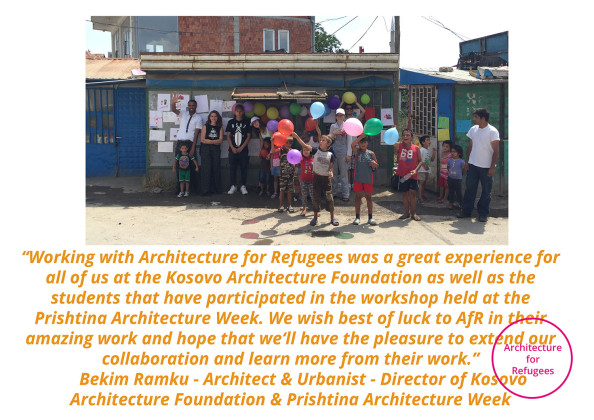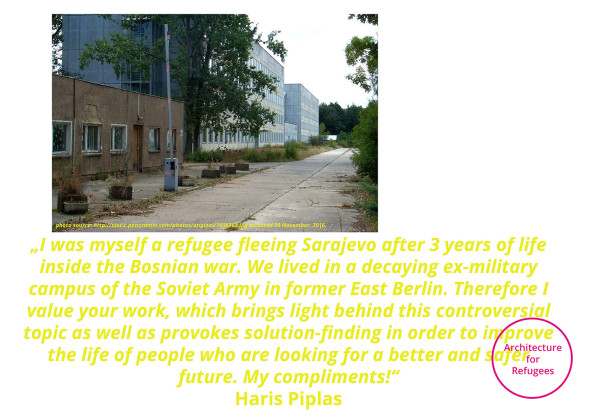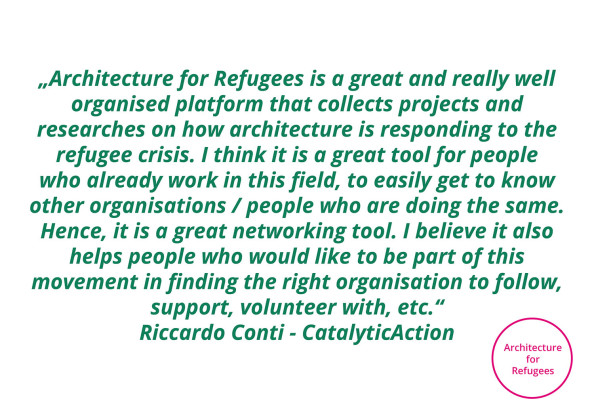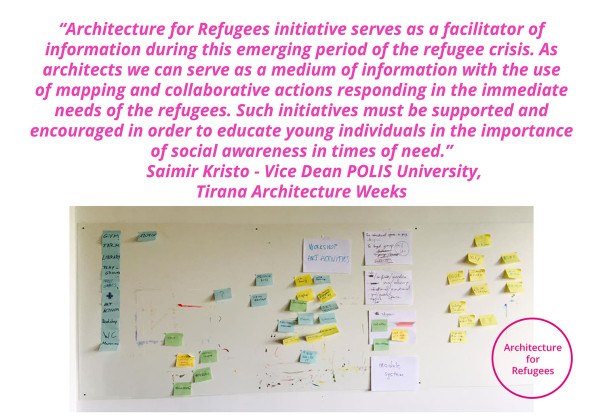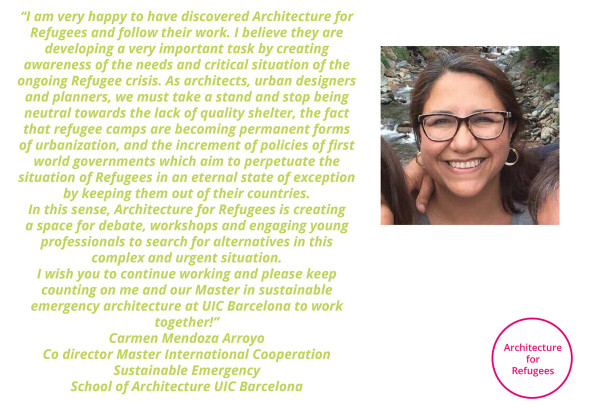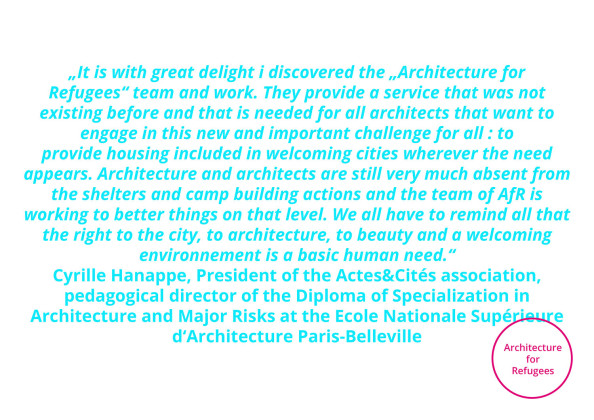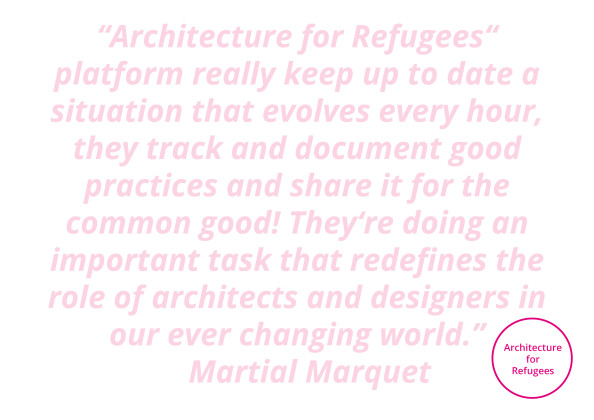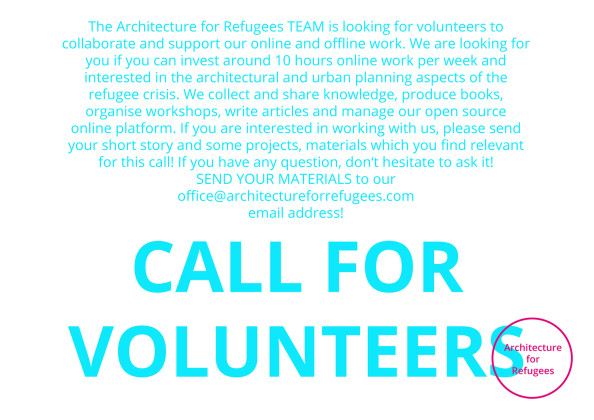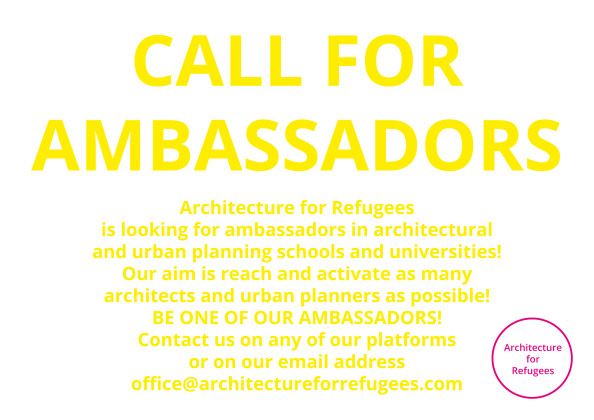Building Common Ground: Architecture of Game Changers
Architecture For+With+By Refugees is an open source online platform that explores and shows ideas, projects, buildings, workshops and open calls including refugees from worldwide since 2015
Architecture For+With+By Refugees is an open source online platform that explores and shows ideas, projects, buildings, workshops and open calls including refugees from worldwide since 2015. We talked with Bence Komlosi about their concerns by launching this platform and their book, and thoughts about the social role of the architecture.
Dirim Dincer: I came across your platform while searching for the relation between architecture and refugees; and I realized that you, with Zsófia Glatz, were dealing with the housing problem in Budapest. I think it is important to consider architecture’s role in the society. So, we can start from there. What were you doing before you launched the platform?
Bence Komlosi: Our team had several partners. Like Zsófia, we have Denise Castillo, who is also an architect that is working with us. We are all architects here, and we are trying to do something for the society by doing not only architectural design, but more. That is our background: we are designing houses and multifamily housings, etc; but we all want to do more for a better built environment. This moves us on a daily basis. In September 2015, Zsofia and I were in Budapest, and the refugee influx arrived just at that time. This was new for us, and we didn’t know anything about it. I don’t know why but for Europe, it wasn’t really an issue until the Balkan Crisis a few years ago. This was new to us. We wanted to know what was going on, because you can read a lot in the media, but of course, it is never clear. So, we said “Yes, here is the situation. We can go there and see who these people are.” When we went there, we realized that these people were like any of us. They were fleeing somewhere to have a better life. There were four young guys playing with toy cars. My brother also really likes playing with them; so I thought, any of them could have been my brother. This is a situation that all of us can get into any time, by doing anything. So we wanted to do something about it; and we started to work as ordinary people, but that wasn’t enough for us. We also wanted to use our profession and our architectural knowledge; and deal with these problems through that perspective. We started the Architecture for Refugees platform in 2015 to deal with the refugee crisis. I think this is the background story of who we are. In the end, we are ordinary architects, designers. We were, and still are, doing research about housing, democracy and architecture, sustainability etc.
As an architect, one may ignore this crisis by thinking, “Nope, it is not my issue”; or one may care. If you do care, you try to build up a perspective towards this urgent issue, but I think positions can’t be constituted firmly yet, at least that is what we are experiencing in Turkey. Yes, there is a global-scale interest in the issue, but what do you think about the constitution of such a culture? I mean, designing a shelter is not enough; but what is ‘enough’? Considering the design practice, and the politics towards the refugee crisis; as long as refugees continue to live in camps, what is the meaning of designing the best camp? Considering the political and cultural aspects, I don’t know the answer. For me, as an individual, I can have some ideas, and I can force my political ideas to do something about it. But as an architect, I think it has nothing to do with the profession.
I don’t remember who said this, I think it was one of my colleagues; he said “you can try to design the best refugee camp, but it is still going to be a bad solution.” Refugee camps are too general, and they are not good solutions for hosting the refugees. People in there are going to be isolated from society, and will have a “special status” for who knows how long. Right now, the average time spent in a refugee camp is 15 to 17 years. It is almost an entire generation. To be isolated for 17 years does nothing for being good; and their whole life, and inevitably, their whole society, is going to be ruined.
So I think that there are no good camp solutions really, but if I am to say something positive, I would say that it goes back to the similarities between cities and camps. Refugee camps are like cities. You can find several hundred books about good cities. And you will see different aspects of the city in the camps; from public areas to green areas, or a diversity in the functions of the city, or public transport, community spaces, etc. I think there are also issues with camps.
DD: So is architecture the right field to create a solution for this issue, or be involved with?
BK: Of course it is, and architecture should be more involved in the discussions, whether by building camps or cities. Your built environment is everywhere, in your whole life. It has a really huge influence on your life; so architecture’s involvement is very important. Right now, refugee camps are like military camps. They are functioning very well for your body. You have shelter, shower etc.; and first aid for basic needs. But for your mind or soul, you don’t get anything, because there are no community spaces in camps. The structures are just functional, but not emotional. In this sense, it is important for architects and urban planners to be involved.
DD: This also shows the importance of multidisciplinary processes. Architecture all alone can’t solve any problems, and more importantly, social sciences can build the foundation of a life-time solution to these problems, such as doing short-term camps or building new forms in the city. This perspective shows that architecture is not only about hope, but is one of the essential pinions of solutions; this can make an architect more prudent. Your logo says; Architecture for+with+by Refugees; which is very inclusive; and carries the potential of doing things together. In this sense, I also wonder about your opinions on the differences between architecture for disadvantaged people, and architecture for refugees. How do you describe that?
BK: We really want to focus on refugees because they have a very special social, and legal, status. If we talk about minorities or disabled people in a society, on one hand, it is a similar situation; but on the other, they are somehow part of the society. Refugees however are in an even worse situation. They are coming from another country, they are external people in a new country. That’s why we focus on refugees, even though we can learn a lot from the other disadvantaged people—things such as how we can give architectural answers to problems through new strategies. The other reason is to highlight the state of refugees for the architectural society. Their needs, which are the same as yours or mine, have to be discussed. There is an example of an organization in France called Perou, and they are trying not to focus only on refugees, but on minorities as well; saying that they are fighting for solidarity and equality. They are still dealing with minorities, and it is quite important to say that you fight for someone’s equality.
DD: With the experiences you have from your platform, and considering the design side of the fight for this universal crisis, is universal design possible? What about contextual inputs? What are, in this sense, the differences among projects?
BK: There was a MoMa exhibition which used this term and I think since that time people keep using it: “Think global, act local.” That is trying to highlight the importance of learning together, of zooming out, and learning from different people, situations and experiences on how to deal with the problems. And then go back and use that gained knowledge in a local scale. We believe in this, and we try to do this kind of knowledge transfer, because we believe that this crisis is generic, and that we can learn from very different parts of world. This knowledge can also be used in the local scale. As we got to see, within a year and a half, the solutions are rather similar, just like the problems are. So what we try to do is transferring the existing knowledge. People still start their new projects from zero, without knowing anything, and then having the experience. Instead of learning all of these things after starting from zero, know them prior, use this knowledge, and start from two, three steps further.
DD: Should an architect have social responsibilities? How do you evaluate the worldwide perception on the architecture’s role in society?
BK: On one hand, architecture can both be social, and not social; it depends on, let’s say, the “client”. The client can be a capitalist person, who likes money the most, or the client can be a democratic body, such as states or municipalities; and thirdly, the client can be an individual or a community. We think that architecture as a profession only serves these different clients. If there is a client, we can do something; but if there is no client, it is very hard to do anything. So different architects can decide on what they want to do. Are they going to be social architects, dealing with social problems in the society? Or do they want to go with the clients that have more money; dealing with less social, and more economic problems? We always have the same kind of question: What was first, the chicken or the egg? Society or client? But architecture is only a reaction. So you always have a client who asks for something. Even in the refugee crisis there are clients; but of course, they are passive clients; because they don’t ask for anything. But the architect should change this action-reaction scheme. We believe that architecture should start to be proactive, to develop new ways of working together with the clients; in this particular case, with refugees. And architecture should be the first one to say, “They are refugees, and we should answer their needs.”
DD: But you think it is just personal.
BK: Yes, it is really depends on who you are, who we all are, and what we want. Are we dealing with the refugee crisis, or turning around and saying “it is not my problem”?
DD:I think another important issue is the changes in the urban fabric and paradigms of living together—of commons. Refugees have, and form, a new kind of space perception; so how are these requirements realized in the city? What do you think about cities in the near future as places of mutual living?
BK: I think there are two directions to go on the matter; one is towards what we believe in, while the other is towards reality. The reality is going towards the direction of individualism in a strong capitalist way, where the individual needs, money and control mechanism are significant in the way of developing cities. The other direction is about people, who should drive the development of their cities; it is about the needs of the people, not only a specific person, but the whole society.
Ideally, these two things should go hand in hand, develop with each other, and have a balance between them, for the making of a good life, but that area is still dominated by money, and not by communities, or people. Living together is very important, on which we really focus, in terms of developing ideas and strategies together, while asking “How can we develop our cities?” So we, architects, learn new ways of designing with the community and its users; and not only with a client who decides on everything, and tries to have everything that he or she wants.
The diversity of the cities, with different functions and people in the same place, is very important; and we believe that the city must be colorful, and not segregated. The people can mix with each other; and this is also true for functions, such as public, educational or community spaces, housings... They must have a good balance in a city.
DD:On the platform, there are built projects, sketches or ideas. It is wide in scale, and I think it is a very inclusive way of collecting and sharing. How do you get this information? How does it work? Do you make formal collaborations with NGOs and universities? Do you want to be a guide or a catalyst for designers, architects, and other responsible human beings?
BK: In most of the cases, we still have to go to the people. We find the people, and then we start the collaboration. In the beginning, we were just looking for the materials and we were posting them. Now, we are getting more feedbacks, and numerous collaborative partners saying, “I would like to do this, or that; we should do it together”. We have a lot of calls for articles, collaborations etc…. We also want to generate a discussion. What kind of materials do we collect? We collect everything connected to refugee crisis and built environment. We only have these two keywords: refugee and architecture. We collect and share everything on this topic, and we don’t curate these materials; we publish everything. On the website, we aim to create an open source online platform, so that everybody can login and immediately post materials. People will generate knowledge only by using the platform. Now that we are getting more involved, sometimes I think, “Should I post this, or not?” For example, as an individual I don’t like the project, but I post it anyway; considering that maybe it could be useful for a different person in a different aspect.
Also being the catalyst of a network, as you just said, is very important for us. We are still developing, but we connect people. We know someone in France, and then someone looking for something in France; so we connect them. There was a university program in Germany. They wanted to visit Berlin. We just posted it as “we are looking for projects in Berlin” and people immediately reacted. We get 20 or something projects that can be involved with student visits. So yes, we try to connect a lot of people, and also publish everything that is somehow interesting. I think it is getting better now, but it takes a lot of time. It is very important to reach more people. Right now, we have over 4000 followers—which is still nothing. I can say nobody knows us yet. When we reach the global scale, then we will really be able to connect people.
DD: How do you position yourself? Are you a documenter or a game changer?
BK: We want to be game changers, while doing documentation and knowledge transfer; because we believe that this is right way of changing the game. We are researchers, and we always try our best to find answers to problems. Right now, with this refugee crisis, we figured out that there are a lot of local projects, which are very good onsite, from Jordan to Turkey, to Germany. But they don’t know each other, so they can’t learn from each other. They always start from the very beginning. This is what we found out. We think that we should have a global platform where people can share their knowledge and experience so others can learn from them. That is how we change our game. We believe in networks, platforms and international discourse. We can scale the process up.
I don’t believe we are doing something that is very unique. We are using a lot of projects or models that have already been used before. We are just using them for this topic. They are not new; but they do need to be used. If it is not actively used, then it is not functioning.
DD: You are working on a book, From Field to Field. What do you want to achieve with that book?
BK: We have been collecting and sharing since 2015, and as I have already said, we don’t curate anything. But we always wanted to have a curatorial version of the collection, in order to summarize the best practices, and all the different aspects. There are around 10 subtopics which are important: camp designs, refugees in urban areas, educational buildings for refugees, etc. … We wanted to characterize different topics. Now we are developing all this as a book, our first curatorial material; as a version of the transfer of knowledge. So we invited many different amateurs and professionals from all around the world, with several years of experience on the field about our topics. And we asked them to share their knowledge in a way that can be understood. Refugees who shared their stories about what they had learned during the journey are involved in the book as well, so are the amateurs who just visited some refugee camps, and hope to share what they learned through their involvement in the process. It is very important for us that anyone who opens the book can find answers for their questions. “What can I do?” or “How can I do anything?” That kind of “how to” questions can find little answers via the book.
DD: How does your project selection work? Do you have a framework?
BK: We defined 5 chapters that are for diverse countries and different situations. For example; internal displacement, neighboring countries –like Turkey, in this case; transit countries that people just pass by during the journey, and the arrival countries. Anybody who opens the book can understand the process, and what they can do to help. It is possible to understand that where you are in this whole situation. We find short and long term solutions, and come up with ideas that are very important. There are a lot of discussions about short-term strategies like shelter designs, or camps; but there is only a very small discussion about long-term projects. We really try to show everyone that we need both.
We have a chapter about body and mind, which is about spaces or programs for your body, mind and soul. Again, we believe that these have to be developed hand in hand to get good solutions. For example, we went to the Calais Refugee Camp, now demolished; but it was the perfect place for your mind because there were school programs that included language learning, playing games, music etc. People had their own communities, discussions with neighborhoods, and so on. But the physical conditions were so bad. It was a perfect place for your mind, but a terrible place for your body. And then the next camp which is just a few kilometer far from there, Dunkirk, which still exists. It is a perfect place for the body, with standardized shelters and showers and such, but there was no social life, no program... These have to be in balance. Even when we are talking about refugee camps, or cities; there has to be balance.
And the fourth chapter is about the role of the architect, about how the architect or the urban planner can start acting, and doing something. We will try to introduce different aspects and ways of doing it. And the last chapter focuses on what you can do even if you have small amount of time; which is for individuals. It is like a to-do’s list: what can we do, or what should we do? We use this very often: “many smalls make great.” Nobody has to be a superhero. We have a lot of people dealing with this situation, and adding a small extra effort can create a lot more than having five superheroes work on it. These are some of the aspects of the book’s five chapters. We have 20-25 partners throughout the chapters. We have exhibitions on certain topics, and projects, for example, one that is built in Greece. The goal is transferring knowledge from these people, who have several years of experience, to others by not showing only with sexy photos, but with understandable material.
DD: What about the platform? What do you plan for its future?
BK: The main goal is to reach more people, because that would be the ideal way to do this. That is our goal: to encourage people to use the platform, so they can share their knowledge, and also to reach people who are still doing something on the topic, but would like to do more; and finally, to show people that it is easy to do something. This is what we are trying to do this year and we are also trying to connect with some local partners in different countries, like friends—people who can start the local process. I also think that it is very important for Turkey to have this kind of a discussion. Actually, what we are doing is not only about architecture, but about communication. These are the crucial parts of the process: to have discussions, to learn about the situation, and to understand what is going on, as well as what the architectural aspects are with regards to how we can work together and how we can support each other. Even though right now, it is Architecture for Refugees, and not by+with+for Refugees; it is only because we wanted to shrink the title, but we really like finding others to collaborate with, and enriching ways of doing things.
DD: I think being “by+with+for” takes time because refugees also try to position themselves in the arrival cities, as well as the transit countries or neighboring ones. By the way, regarding this issue, these countries experience a challenge about the democratization process too. It is really hard to do to position yourself while having no rights there, for example. And if you don’t have the legal right to work, to get an education, or even asylum, you can’t really be imagining how your built environment should be.
BK: Or your future—that is totally true. It is a development process and it is, again, about short or long term strategies. First of all, we would like to collaborate with refugees and new comers; and they would also have to learn something, participate, and collaborate. In our daily and weekly discussions, which are about how we can do things, we discuss these issues. Even after we started the discussion, however, it is hard to keep things working, and to encourage them. For example, last week, we had a discussion here in Switzerland, and one guy said, “You know what, I would like to integrate myself, but I am without status, so after a while I give up. I can’t do anything anymore because I can’t see my future. I don’t know what is going to happen tomorrow. Why would I do anything? No status, no integration.” And this is true. With this attitude, they will not be doing anything; so we can’t go on.
The answers that I gave to you are never true or false, right or wrong. Things always should be in balance. We also believe that if it is too radical, it is probably wrong. We always try to be somewhere in between. So being in balance will probably be the better solution and the better direction to take.
Related Content:
-

The City Yet to Come
-
Participatory Design is the New Black
Cities are complex organisms that are able to develop themselves at an incredible speed and in different conditions.
-

Beyond Borders
-
Architecture Ablaze
'If cold, then cold as a block of ice. If hot, then hot as a blazing wing. Architecture must blaze.'
-
Reframing the Social
Hülya Ertaş talked to Florian Koehl on the social agenda of architects today and the alternative ways of realizing projects within the existing social and economical framework
-
Unlocking Architecture’s Potential to Invest in Future
Engin Ayaz and Christian Benimana of MASS discuss how architecture should function, as well as looking into the facts of social design in Africa
-
Inhabiting the Earth in Symbiosis with the Environment
Aixopluc takes on the challenge to find new modes of inhabitation in symbiosis with planet earth
-
Responding to Refugees’ 'Design' Crisis
Displacement is at the first place, and foremost, a spatial phenomenon. Despite of being perceived as “temporal guests”, refugees are urban actors whether in camps, villages or cities
 07.04.2017
07.04.2017



